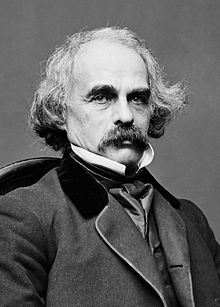(1804-1864) was born on July 4, 1804 in Salem, Massachusetts, to a prominent family. Family and local history, some of it drawn from Raymond, Casco, and the surrounding area where he spent many summers between 1813 and 1825, provided much of the material for Hawthorne’s works.
The “Hawthorne House” is maintained as a historic site and is open for visitors in the summer. When Hawthorne was at the house it was in Raymond. In 1841 the new town of Casco was formed from a portion of Raymond, including South Casco where the house is still located.
After his father’s death, relatives recognized his literary talent and financed his education at Bowdoin College. Among his classmates were many of the important literary and political figures of the day: writer Horatio Bridge, future Senator Jonathan Ciley, Henry Wadsworth Longfellow, and future President Franklin Pierce, who helped Hawthorne with government employment, allowing him time to develop as an author.
From 1836 to 1844 the Boston-centered Transcendentalist movement, led by Ralph Waldo Emerson, was an important intellectual force. Hawthorne’s fiancée drew him into it, and in 1841 he invested $1500 in the Brook Farm Utopian Community, leaving disillusioned within a year.
His later works show some Transcendentalist influence, including a belief in individual choice and consequence, and an emphasis on symbolism. America’s first true psychological novel, The Scarlet Letter would convey these ideals; contrasting puritan morality with passion and individualism.
Having lost his post in a custom house in 1849 for political reasons, Hawthorne returned to writing, and the produced the satirical “The Custom House.” Hawthorne followed with the Scarlet Letter, much of which he wrote at his mother’s home in Casco. In 1850, adultery was an extremely risque subject, but because he had the support of the New England literary establishment, it was considered acceptable.
According to Herbert Edwards in Downeast Magazine, September, 1962:
Nathaniel Hawthorne said later that the many years he spent at Raymond, on the shores of Lake Sebago, were the happiest of his life. He was twelve years old when his widowed mother left Salem, and with her son and two daughters, went to her brother’s lake-front house at Raymond. Here her brothers, Robert and Richard Manning, owned 12,000 acres of forest on the shores of the great lake that lay at the foot of the mountains.
Beside the house, still standing, rushed Dingley Brook, which turned the big wooden wheel of Jacob Dingley’s grist mill before it poured into the lake.
Westward stretched an unbroken expanse of forest as far as the eye could see. Uncle Richard gave the young Nathaniel a shotgun from his large collection, and game of all kinds, from partridge to deer, was plentiful. The brook and lake were full of fish, and on many occasions the boy caught a dozen large trout in less than an hour. Sometimes he and his sister Elizabeth, who loved to walk, went far into the forest; often they would start off early in the morning and not return until late afternoon.
Hawthorne served a four-year term as U.S. Consul in Liverpool, having been appointed by his former classmate President Franklin Pierce. After living in Italy and England, he returned to Concord, Massachusetts. He died in May of 1864 while visiting New Hampshire with Pierce.
Additional resources
Bell, Michael Davitt. Hawthorne and the Historical Romance of New England. Princeton, N.J. Princeton University Press. 1971.
Edwards, Herbert. “Nathaniel Hawthorne in Maine.” Downeast Magazine, September, 1962. Hawthorne, Julian. Nathaniel Hawthorne and his Wife: a Biography. Grosse Pointe, Mich., Scholarly Press, 1968.
Hawthorne’s “Pot-8-0 Club” at Bowdoin College. Salem, Mass. 1931.
James, Henry. Hawthorne. Ithaca, N.Y. Great Seal Books. 1956.
Merrill, Mabel S. The Boy with the Talisman. Lewiston, Me. The Journal Printshop. c1924.
Turner, Arlin. Nathaniel Hawthorne, A Biography. New York. Oxford University Press. 1980.
Wineapple, Brenda. Hawthorne: A Life. New York. Alfred A. Knopf. 2003.
Nathaniel Hawthorne by Brady from Wikipedia. https://en.wikipedia.org/wiki/Nathaniel_Hawthorne (accessed February 20, 2019) [Public Domain]



